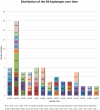Plasmodium vivax sub-patent infections after radical treatment are common in Peruvian patients: results of a 1-year prospective cohort study
- PMID: 21297986
- PMCID: PMC3030575
- DOI: 10.1371/journal.pone.0016257
Plasmodium vivax sub-patent infections after radical treatment are common in Peruvian patients: results of a 1-year prospective cohort study
Abstract
Background: There is an increasing body of literature reporting treatment failure of the currently recommended radical treatment of Plasmodium vivax infections. As P. vivax is the main malaria species outside the African continent, emerging tolerance to its radical treatment regime could have major consequences in countries like Peru, where 80% of malaria cases are due to P. vivax. Here we describe the results of a 1-year longitudinal follow up of 51 confirmed P. vivax patients living around Iquitos, Peruvian Amazon, and treated according to the Peruvian national guidelines.
Methodology: Each month a blood sample for microscopy and later genotyping was systematically collected. Recent exposure to infection was estimated by detecting antibodies against the P. vivax circumsporozoite protein (CSP) and all PCR confirmed P. vivax infections were genotyped with 16 polymorphic microsatellites.
Results: During a 1-year period, 84 recurrent infections, 22 positive also by microscopy, were identified, with a median survival time to first recurrent infection of 203 days. Most of them (71%) were asymptomatic; in 13 patients the infection persisted undetected by microscopy for several consecutive months. The genotype of mostly recurrent infections differed from that at day 0 while fewer differences were seen between the recurrent infections. The average expected heterozygosity was 0.56. There was strong linkage disequilibrium (I(A)(s) = 0.29, p<1.10(-4)) that remained also when analyzing only the unique haplotypes, suggesting common inbreeding.
Conclusion: In Peru, the P. vivax recurrent infections were common and displayed a high turnover of parasite genotypes compared to day 0. Plasmodium vivax patients, even when treated according to the national guidelines, may still represent an important parasite reservoir that can maintain transmission. Any elimination effort should consider such a hidden reservoir.
Conflict of interest statement
Figures



References
-
- Roper MH, Torres RS, Goicochea CG, Andersen EM, Guarda JS, et al. The epidemiology of malaria in an epidemic area of the Peruvian Amazon. Am J Trop Med Hyg. 2000;62(2):247–256. - PubMed
-
- Roshanravan B, Kari E, Gilman RH, Cabrera L, Lee E, et al. Endemic malaria in the Peruvian Amazon region of Iquitos.Am J Trop Med Hyg. 2003;69(1):45–52. - PubMed
-
- Ministerio de Salud Peru. Direccion General de Epidemiologia. Situacion de la malaria en el Peru 2009. http://www.orasconhu.org/documentos/2%20Iquitos%20junio%20-%20Situacion%.... (accessed 28 March 2010)
Publication types
MeSH terms
Substances
LinkOut - more resources
Full Text Sources
Research Materials

